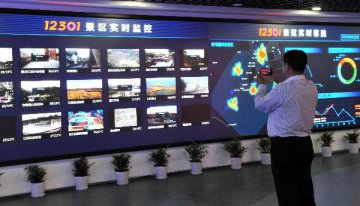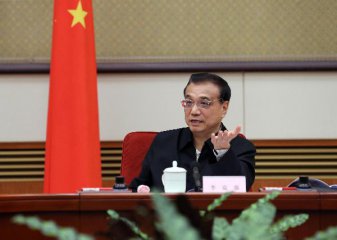
What's the easiest way to get a comprehensive picture of China's economy and society? "The five-year plan" is one possible answer.
Since 1953, China has produced 13 five-year plans. These blueprints for national economic and social development are receiving ever increasing praises abroad as Chinese wisdom worth learning from.
The 12th Five-Year Plan for National Economic and Social Development (2011-2015) is a good example, as the country fulfilled all the major tasks and targets as planned.
The 13th Five-Year Plan for the 2016-2020 period, approved on Wednesday by the National People's Congress (NPC), China's parliament, is a new chance to examine how the world's second largest economy forecasts its future, plans its goals, deal with challenges and transform itself. Here is a summary of the highlights in the 12th and 13th five-year plan decade.
ECONOMIC ENGINES
The Chinese economy managed an average 7.8 percent annual growth over the past 5 years, while many developed nations still struggled to recover. In 2010, China's GDP was 5.9 trillion U.S. dollars, overtaking Japan as the world's second-largest economy. In 2015, its GDP rose to 10.42 trillion U.S. dollars, accounting for 14.4 percent of global GDP. The 13th five-year plan sets a growth target range from 6.5 percent to 7 percent a year, and forecasts China's GDP will exceed 14 trillion U.S. dollars in five years, continuing as the world's economic engine and narrowing the gap with the United States.
Hu Angang, an economist with Tsinghua University, forecast China's per-capita GDP will be 10,000 U.S. dollars by 2020, and the gap between the two biggest economies in per-capita GDP will close from one seventh to one third.
Some foreign analysts say China's emergence as the biggest economy is only a matter of time.
GREAT CHANGES
In 2010, when Xiaomi was founded, the Chinese smartphone market was dominated by foreign brands. Newspapers splashed photos of people queuing for Apple's iPhone 4 and few would consider buying handset from a domestic startup. Five years later, Xiaomi, with a market value estimated at 45 billion U.S. dollars, was China's leading smartphone vendor and ranked very high in the global market. The smiling face of its founder has frequently graced the pages of the Wall Street Journal and Forbes, while Wired stated "It's time to copy China." Xiaomi's success is shared by many Chinese high-tech companies that have ridden the Internet boom over the past five years. In 2015, more than 668 million Chinese had access to the Internet, almost half the population, and mobile phone web users numbered 594 million.
China-based social networking apps such as WeChat and Sina Weibo initially imitated WhatsApp and Twitter, but they adapted and maintained their popularity by constantly introducing new functions.
Alibaba, China's e-commerce giant, set its initial public offering (IPO) price at 68 U.S. dollars per share and raised 21.8 billion dollars, making a record-breaking IPO launch in 2014. Its founder Jack Ma famously said, "Yesterday, you didn't want to talk to me (because I was nobody back then). Today, I am so successful that you can't reach me." This quote is viewed as a true reflection of China's Internet power.
In the next five years, the Internet will be a pillar industry for the Chinese economy by transforming traditional industries and companies. People will enjoy faster, cheaper Internet services and more information infrastructure. When China was founded in 1949, it was a big but poor agricultural country, with a mostly rural population; since reform and opening-up in 1978, urbanization has accelerated.
Over the past five years, the urban population for the first time outnumbered the rural population, with about 55 percent of Chinese living in cities.
Meanwhile, rural incomes have grown faster than urban incomes for six consecutive years. In 2015, China addressed its future city development in its first Central Urban Work Conference since 1978, laying out plans to increase the urbanization ratio to 60 percent and speed up the assimilation of migrant rural workers into the urban population by 2020. A poll on Twitter launched by Xinhua shows that job creation targets in the new five-year plan impressed web users most. The government has vowed to create more than 10 million new jobs this year and at least 50 million more by 2020.
However, the world's most populous country is also aging, with 220 million people aged 60 or over. To offset the pressures brought by a shrinking work force and an aging population, the new five-year plan proposes raising the retirement age, while a two-child policy beginning this year is expected to result in 3 million more babies every year.
TRANSFORMATIONS
China is rapidly transitioning from a mere participant in the international system to a provider of public goods, said Foreign Minister Wang Yi this month on the sidelines of the national legislature's annual session.
More than 70 countries and international organizations have expressed interest in the Belt and Road Initiative, comprising the Silk Road Economic Belt and the 21st Century Maritime Silk Road proposed in 2013. It highlights transport infrastructure, investment and trade facilitation, financial cooperation and cultural exchanges.
The China-initiated Asian Infrastructure Investment Bank (AIIB), a complement to the international financial system, was formally established in Beijing last year with 57 founding members - both developing and developed - and is expected to offer its first loans in 2016. "We (Chinese) are on the path to major-country diplomacy with Chinese characteristics, helping realize the Chinese dream of national rejuvenation and build a community of common destiny for all mankind," Wang said.
In the next five years, China plans to transform itself from an export-driven economy to an innovation-driven power. Instead of using the traditional "three engines" (capital investment, exports and consumption) to fuel growth, the government is implementing supply-side reforms, including cutting overcapacity, improving supply of goods and services, state-owned enterprise reforms and energizing the non-public sector.
TACKLING CHALLENGES
In the 13th Five-Year Plan period, the Chinese economy is struggling to overcome its strongest downward pressure in decades. However, it must grow at least 6.5 percent a year on average - the minimum required to build a moderately prosperous society - and double the size of the economy and per-capita income by 2020 from 2010 levels.
China will work hard to raise the remaining 55.75 million poverty-stricken rural people out of poverty by the end of 2020 - an aim described as the "hard bones" of poverty eradication.
With the same determination it showed in fighting poverty, China declared war on pollution, as choking smog has become a major environmental and health concern. The PM2.5 measure of particulate air pollution was first mentioned in government's annual work report in 2012. Cutting PM2.5 levels is one of binding targets of the new five-year plan.
Expenditure on research and development failed to fulfill the target of 2.2 percent of GDP in the 12th Five-Year Plan. In the next five years, the investment ratio will rise to 2.5 percent, and the target rate of contribution by science and technology to GDP growth will be 60 percent. The decade to 2020 is an important period in China's history. As a driving force of the world economy, China is determined to become more prosperous.
























Latest comments